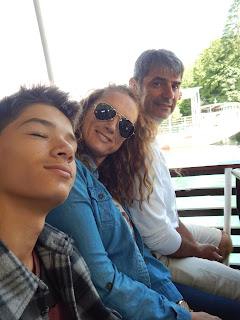Reading Notes- American Indian Fairy Tales- Parts A&B
Reading A-
Right off of the bat, I noticed a feature of these stories
that I, myself, have been trying to perfect in my own storybook. Well, perfect
is a stretch. I guess a better way of saying it is: a style of writing that I
really never conquered before, and am now attempting to conquer for my
storybook. For reading part A, I chose to do the American Indian Fairy Tales
Unit. These stories are told from an outside perspective, or a more technical
term could be third party. Essentially, someone from the outside looking in,
who were either there to witness the actions of the main characters, or someone
in later times who is recounting the stories. In my own storybook, I tried for
a long time to write a very sweet and emotional piece about the main character,
through the eyes of another
character. It was no easy feat! I struggled to make the words flow through
someone else. With the first story in this unit, immediately there were
examples of this. “Iagoo
was a great favorite with the children. No one knew better where to find the
beautiful, colored shells which he strung into necklaces for the little girls.
No one could teach them so well just where to look for the grasses which their
nimble fingers wove into baskets. For the boys he made bows and arrows—bows
from the ash-tree that would bend far back without breaking, and arrows, strong
and straight, from the sturdy oak” (Iagoo, The Story Teller). Just this small snippet of the
story is SO dense with emotion that I felt like I knew Iagoo personally!! It is
exactly what I aim for when I write my stories of Isnana, through the eyes of a
mystery character.
Bibliography: W.T. Larned, American Indian Fairy Tales, American Indian Fairy Tales Unit
Reading B-
For this specific reading, I really wanted to focus on the
small details. By this I mean not focusing on the plot of the stories, but
rather the pieces that make the story come together. Before beginning this
class, and writing all of these stories, I really took for granted transitory
writing. Essentially, the effort that it takes to write all of the small
details without sounding like a third grader. “He did this” and “she said that”,
but attempting to put your college education to good use and using a wide
variety of vocabulary without sounding redundant. By far, a bigger obstacle
that I faced in story writing than I could have ever expected. "Soon they could hear
An-ne-mee-kee coming. Boom, boom! When he shouted in the ear of the Dormouse,
the biggest beast on earth rose slowly to his feet. In the darkness he looked
bigger than ever, almost as big as a mountain. An-ne-mee-kee, the Thunder,
shouted once more, to make sure that the Dormouse was really wide awake, and
would not go to sleep again (The Boy Who Snared The Sun: End). What is
significant about that quote? In terms of story plot, essentially nothing. But it
is all about the fine details! ‘Soon they could hear him coming, boom-boom.’ It
is details like this that us as readers don’t always realize are the reasons
why stories flow, or why they capture our attention. It is this that I
need to focus on for my future writings.
Bibliography: W.T. Larned, American Indian Fairy Tales, American Indian Fairy Tales Unit



Comments
Post a Comment